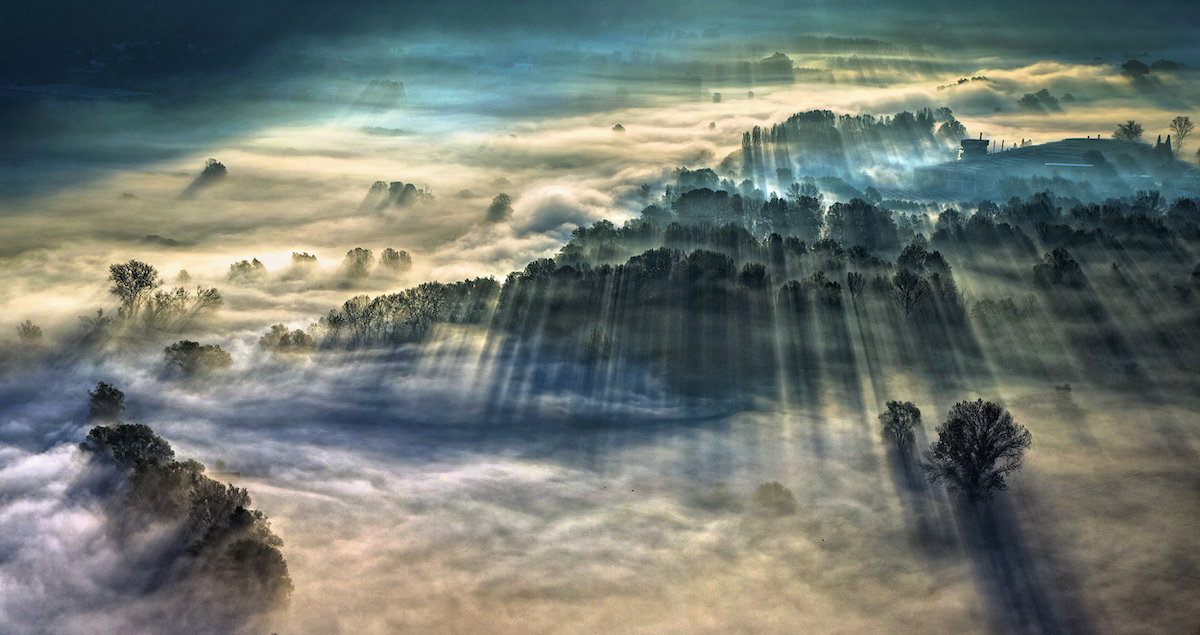
“Morning Fog” by Giulio Montoni (Italy). Winner, Weather Photographer of the Year.
“Giulio captured this image on a foggy autumn day from a small church on a hilltop in the town of Airuno, Italy. Through the fog and with the help of the trees, you can just about see the winding course of the river Adda, illuminated by the first lights of sunrise.
The streaks or beams of sunlight visible in this image are called crepuscular rays. They are made visible by the scattering of sunlight by particles suspended in the atmosphere, such as small water droplets, dust, or smoke. Usually, crepuscular rays radiate through gaps in the clouds, but in this photo, the trees take the place of the clouds, casting shadows across the landscape, and the fog scatters the sunlight. Giulio had to be quick to take this photograph as within 20 minutes the scene had completely changed.”
With nearly 9,000 photographs to choose from, the judges of the annual Weather Photographer of the Year competition had the difficult task of naming a winner. But in the end, it was a stunning photo of a foggy autumn morning in Italy that stole the show. Giulio Montoni‘s Morning Fog earned him the title of Weather Photographer of the Year in the contest organized by the Royal Meteorological Society in association with AccuWeather.
“This photo can only be taken from one point. There is a small church on top of a hill in the town of Airuno, in the province of Lecco in Italy,” shares Montoni. “Under the mist passes the river Adda. In the autumn months, on some days, it is possible to see this show with the first lights of sunrise. After 20 minutes, everything is over. This award repays me for the cold hours endured, waiting for the perfect light for that photo.”
Montoni competed with over 3,300 photographers from 114 countries, many of whom produced award-worthy work. That includes second runner-up Serge Zaka. The French photographer took home the Public Vote for his perfect photo of a lightning storm in the Bay of Cannes. Crisp and clear, Zaka’s image has deep contrasts of light and shadow created by the storm. There was also plenty of imaginative photography, as evidenced by the selfie taken by Russian photographer Evgeny Borisov. Just after first snow over a lake, he sat in a raft contemplating the weather as areas of the water remained unfrozen. His creative thinking was rewarded with second place in the contest.
New to the competition this year was a category for mobile photography. Christopher de Castro Comeso of Abu Dhabi was named the inaugural winner of the category for his image of Qasr Al Hosn on a foggy morning. Proving that the best photos can happen at any time, he had just dropped his wife off to work when he saw fog forming around the monument. He knew it was a special moment so he captured the moment using the camera he had on hand—his phone.
All of the winners and finalists can be viewed on the competition’s website and we’ve gathered some of our favorites below.
Check out more award-winning photography from the 2021 Weather Photographer of the Year contest.
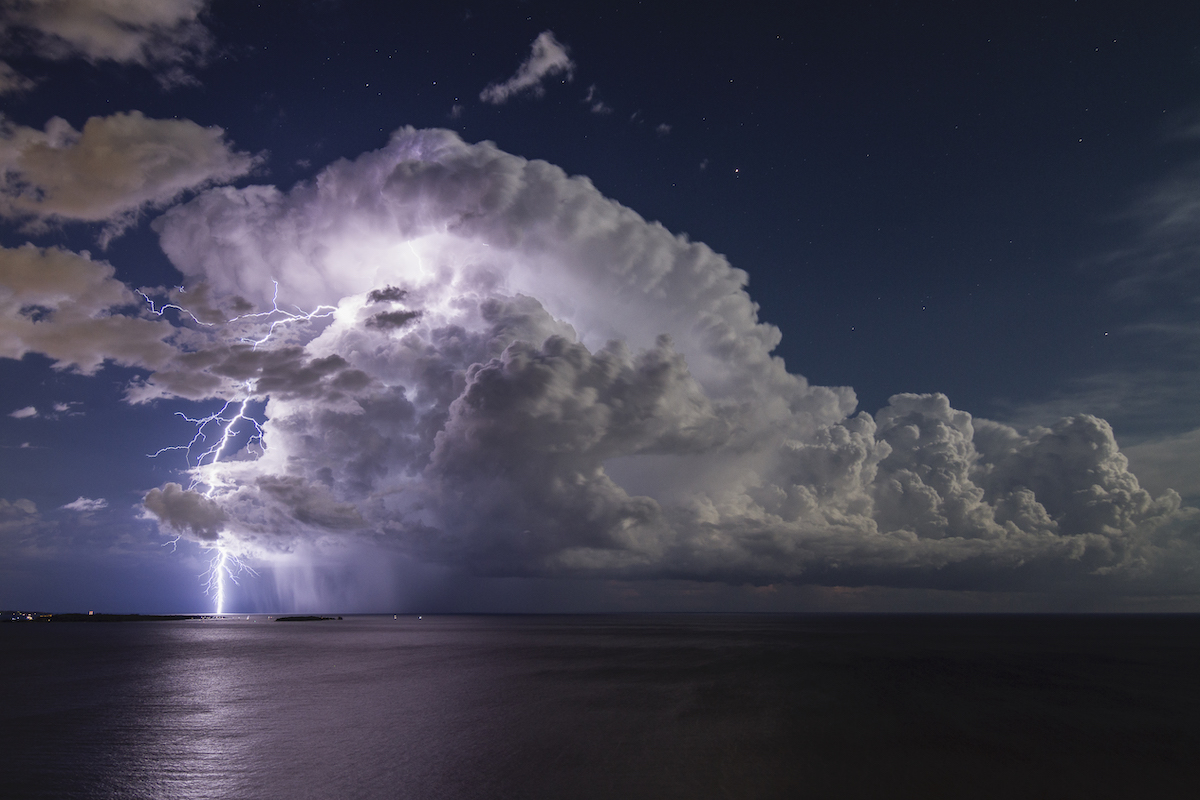
“Lightning from an Isolated Storm over Cannes Bay” by Serge Zaka (France). Winner, Public Vote. Second Runner-Up, Weather Photographer of the Year.
“After driving over 300 miles, waiting for eight hours and a half-night sleeping in the car, Serge finally captured this forecasted thunderstorm on a full-moon night over the famous Bay of Cannes in the south of France. This thunderstorm unleashed several thunderbolts in the clear sky under the stars. There was no rain, no parasite clouds, just the calm of the night and the sound of thunder – ideal conditions! Lightning is a large electrical spark produced by electrons moving quickly from one place to another to neutralize two charged regions – this can be within the cloud or between the cloud and ground. It is the collision of small ice crystals with larger and denser graupel (soft hail) within a thunderstorm that transfers electrons from one to the other. The storm updraught then carries the positively charged ice crystals to the top of the cloud whilst the negatively charged graupel falls towards the bottom. Once the opposite charges build up enough, the insulating property of the air breaks down to form lightning. The air surrounding the lightning channel briefly reaches temperatures of up to 30,000°C, causing the air to rapidly expand, which we then hear as thunder.”

“Self Portrait in a Boat” by Evgeny Borisov (Russia). Runner-up, Weather Photographer of the Year.
“Evgeny took this self-portrait using a Quadcopter at Lake Kok-Kol in Russia. To Evgeny, the uniqueness of the photo lies in his experience of the weather behind the lens – it changed so significantly in the time he was there that he felt the seasons shifted not only between days but over just a few hours.
To capture this shot, he waited for the first snow to fall, which then covered the ice on the lake like a white blanket, leaving areas of open water as vivid streaks in the white.
Have you ever questioned why lakes freeze from the top down? It is because the maximum density of water occurs at 4°C. Above this temperature, as the surface water cools, it becomes denser and sinks, being replaced by warmer water from below. This process continues until the whole lake is around 4°C. Further cooling of the surface water will then form a lighter (less dense) layer of colder water at the top, so the circulation stops. As a result, cooling becomes more concentrated in the upper layers creating ice as the surface reaches 0°C.
Just a couple of hours after taking this photo, Evgeny said the whole lake was covered with white snow and winter came into its own.”
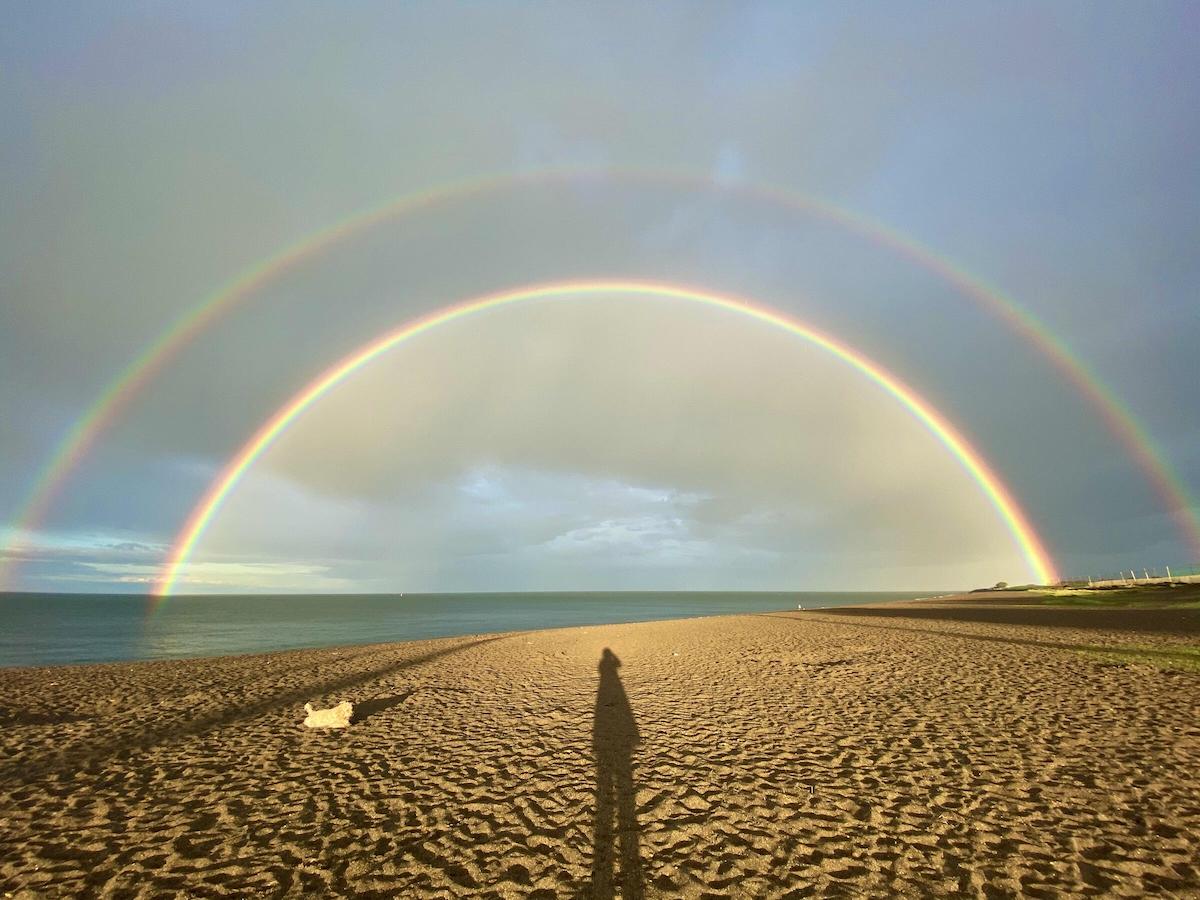
“Between Showers” by Susan Kyne Andrews (Ireland). Runner-up, Mobile Phone Category.
“On a typical May evening on the east coast of Ireland, Susan headed out to her cockapoo Evie’s favorite playground, the South Beach, Greystones.
The minute she stepped onto the sand, the dark clouds gathered, and the heavens opened. Susan describes it as that beautiful warmish rain mixed with low evening sunshine.
As she meandered along, regretting just wearing a t-shirt, she was rewarded with this beautiful double rainbow, as well as a third bow, which was invisible to the camera. She took a couple of snaps on her phone to remember the stillness and emptiness of the beach with only the elements and weather for company.
Rainbows form due to the refraction (bending) and reflection of sunlight as it passes through raindrops. Clearly shown here, the color banding in the secondary outer bow is in the opposite direction to the primary bow, which happens when the light is reflected twice off the back of the raindrops.”
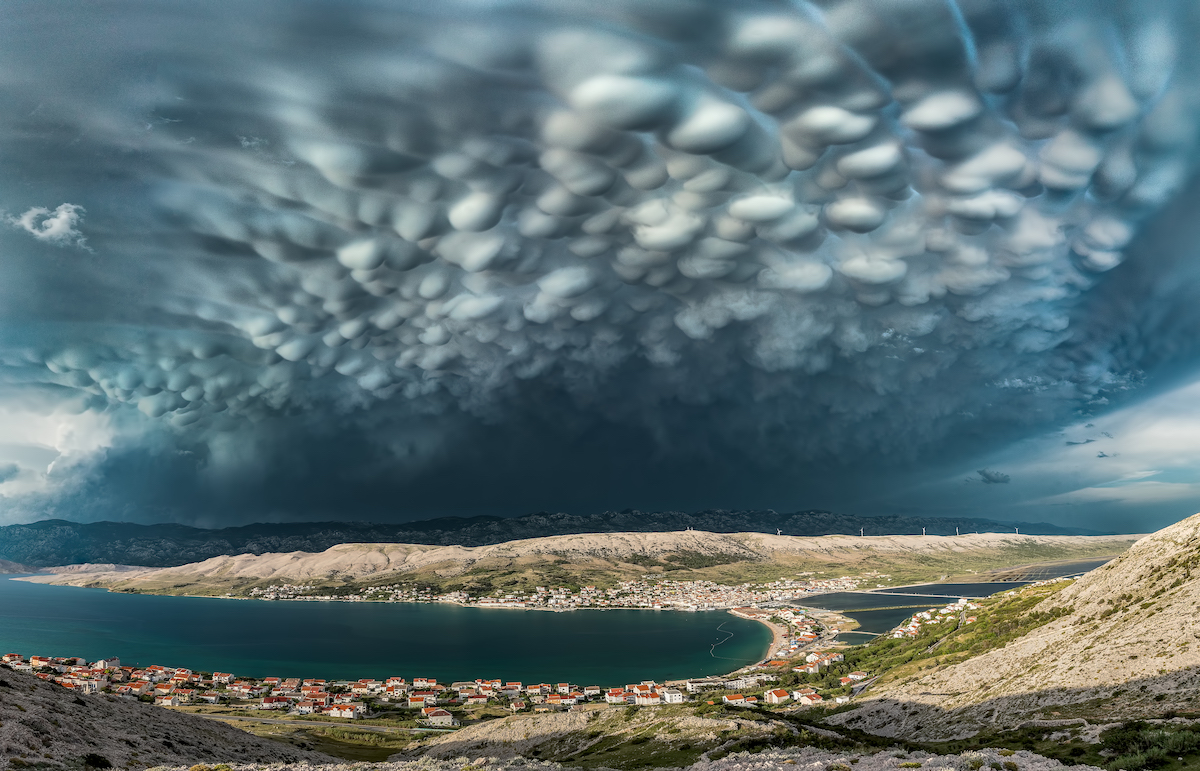
“Beautiful Mammatus Clouds above Pag Town” by Danijel Palčić (Croatia). Finalist.
“The development of a strong storm over mainland Croatia resulted in this epic vista, which Danijel describes as one of the most beautiful scenes of mammatus clouds he has ever witnessed in his entire life. Upon seeing them, Danijel drove to the nearest location on the Island of Pag with the best view of the town and the storm to take a few panoramic shots.
Mammatus clouds appear as a series of bulges or pouches hanging from the base of a cloud and are often said to resemble the udders of a cow. They are thought to form from sinking pockets of cold, moist air and typically develop on the underside of a storm cloud. However, they can also be found amongst other types of cloud, such as cirrocumulus, altostratus, altocumulus, and stratocumulus. Long-lasting mammatus are a sign of large drops and snow crystals in the sinking air. The mammatus clouds seen here soon disappeared after Danijel took his shot.”
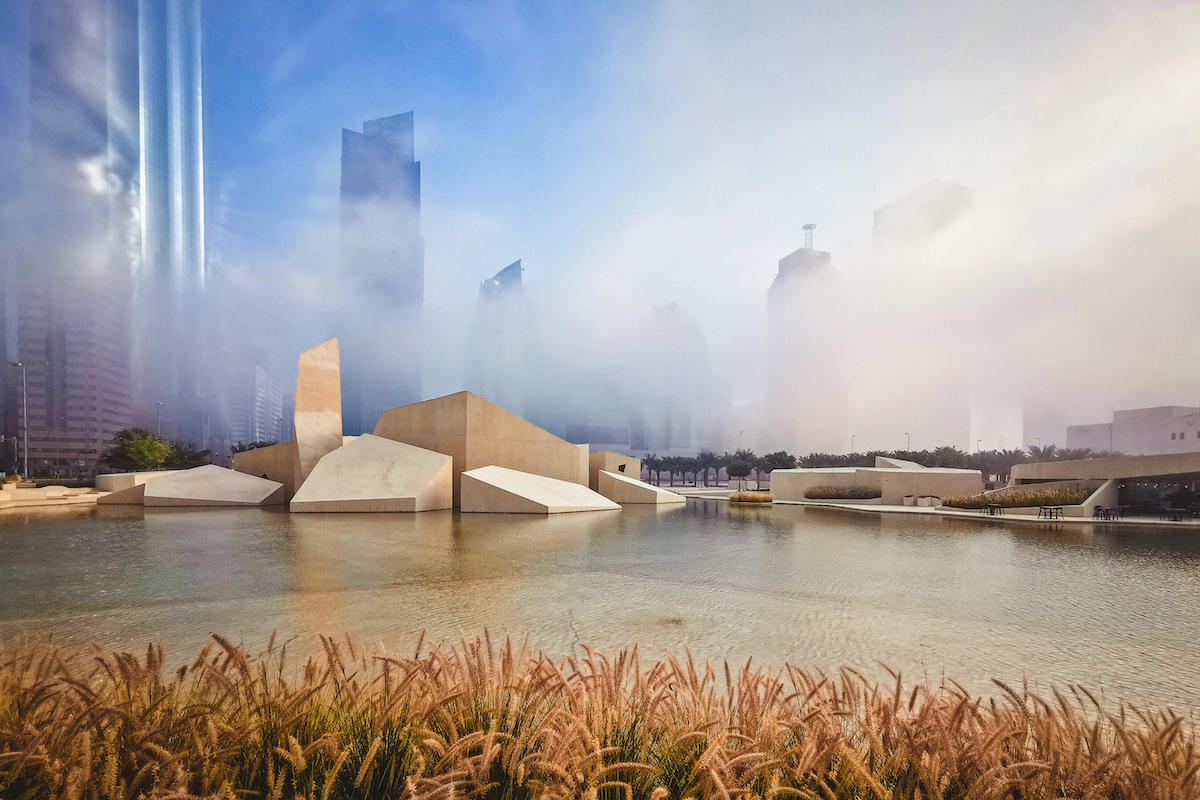
“Foggy Morning” by Christopher de Castro Comeso (UAE). Winner, Mobile Phone Category.
“Christopher took this image of the Qasr Al Hosn, one of the oldest landmarks in Abu Dhabi, UAE, in December 2020 when the temperature dropped.
He was on his way home after dropping his wife at work when he saw the fog forming. Immediately, he took out the only camera he had – his mobile phone – and captured this beautiful shot.
Fog is the term used to describe the suspension of water droplets in the surface layer of the atmosphere, which reduces horizontal visibility to less than 1km. Around 95% of the fog observed in the UAE is radiation fog and is most common in the winter. This type of fog forms over land when radiational cooling reduces the temperature of the near-surface air to below its dew point. The other 5% in the UAE is advection fog, forming when warm, moist, and stable air moves over a cooler surface.
Christopher is thankful for the opportunity the weather gave him to capture this beautiful image. It will stay as a memory forever.”
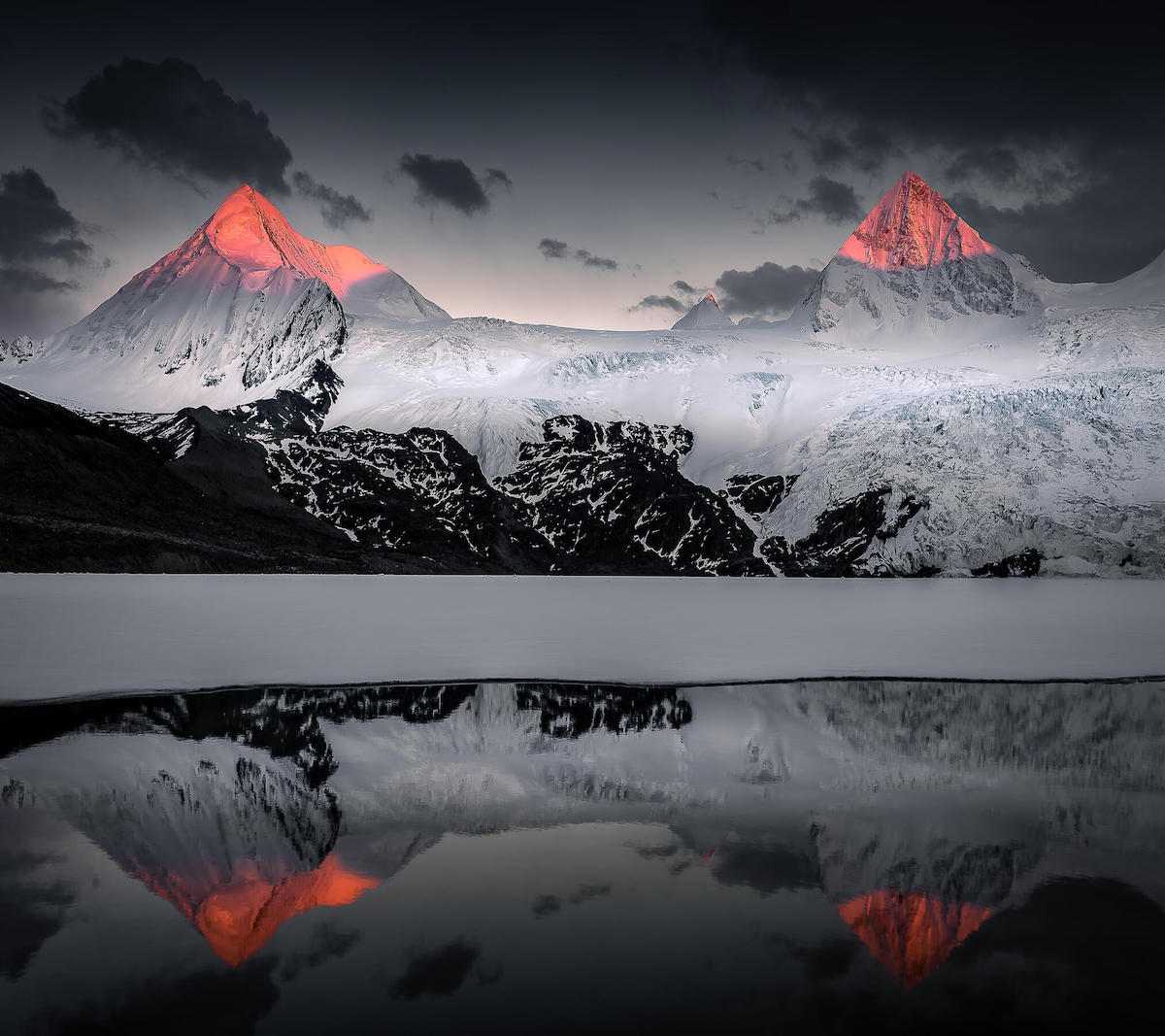
“Floating Red” by Jiming Zhang (China). Finalist.
“At an altitude of 4,800 meters, Jiming took this beautiful image of Sapu Mountain. It had been hidden in the clouds for three days, but at the end of Jiming’s last day, the clouds finally cleared just as the sun set. It is a stunning image with the orange and red hues of the setting sun catching the mountain peaks, all of which is reflected in the lake.
But why are sunsets orange or red? Even though sunlight or visible light may appear white, it is actually made up of a spectrum of colors from red to violet, all of which have a slightly different wavelength. As light travels through our atmosphere, it is scattered by air molecules. This happens more to the shorter wavelengths (blue and violet), which is why we see the sky as blue. When the sun is lower in the sky during sunrise and sunset, the light travels a longer path through our atmosphere. This causes more of the blue portion of the sun’s rays to scatter away from our eyes, leaving relatively more of the longer wavelengths (yellow, orange, and red) for us to see.”
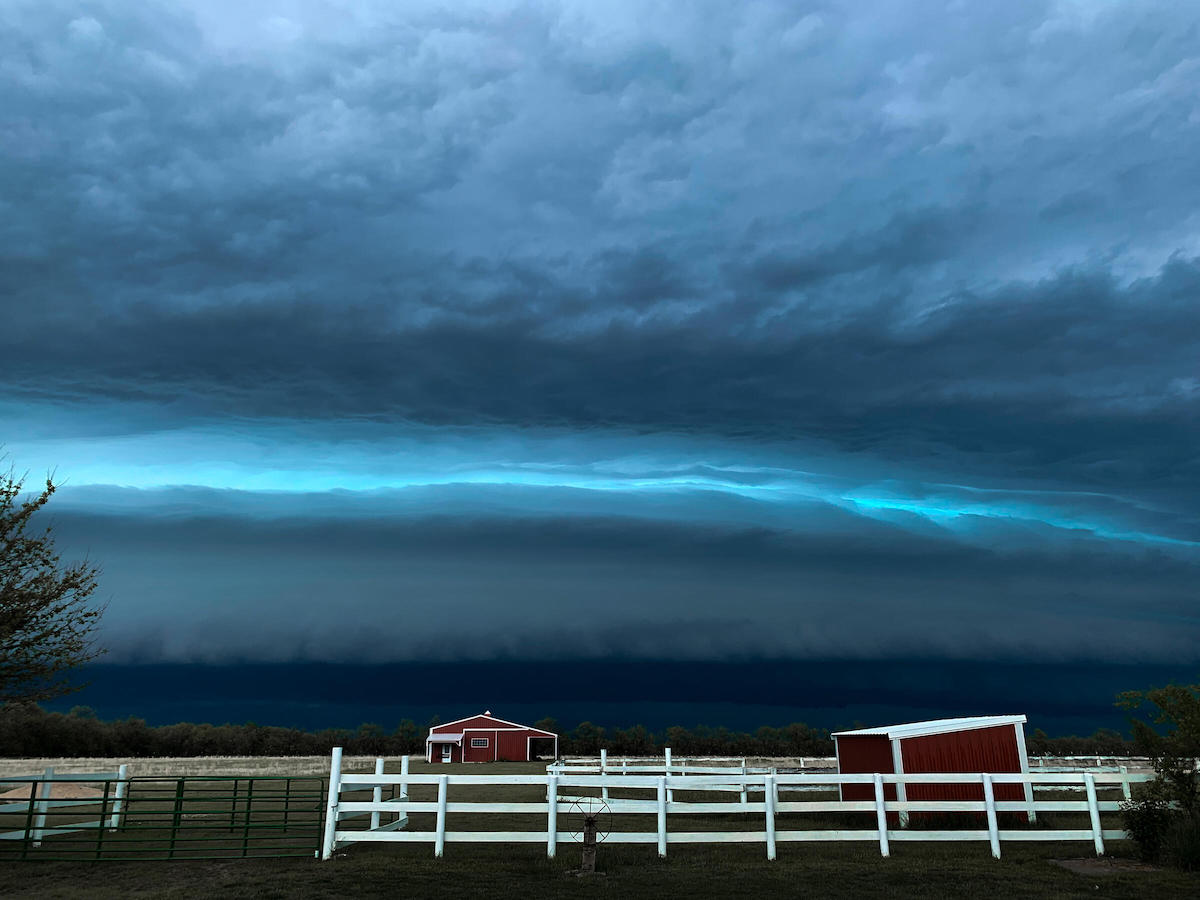
“Kansas Storm” by Phoenix Blue (17) (USA). Winner, Young Weather Photographer of the Year.
“Phoenix captured this image of an approaching supercell in Kansas, USA. A supercell is a thunderstorm with a deep rotating updraught, called a mesocyclone. They are powerful storms that can produce some of the most severe weather, including tornadoes, large hail, damaging wind gusts, and torrential rain.
Over the Great Plains of the central USA, supercell thunderstorms frequently develop during a well-defined storm season that runs approximately from April to June, peaking in May.
Just below the blue-green coloration in the storm, you can see a shelf cloud. Also known as an ‘Arcus’ cloud, it can be easily identified by its menacing, wedge-shaped formation as rain-cooled air flows out of a thunderstorm. Despite their appearance, they are relatively harmless. It’s better to consider them as an indicator of potentially imminent severe weather.”
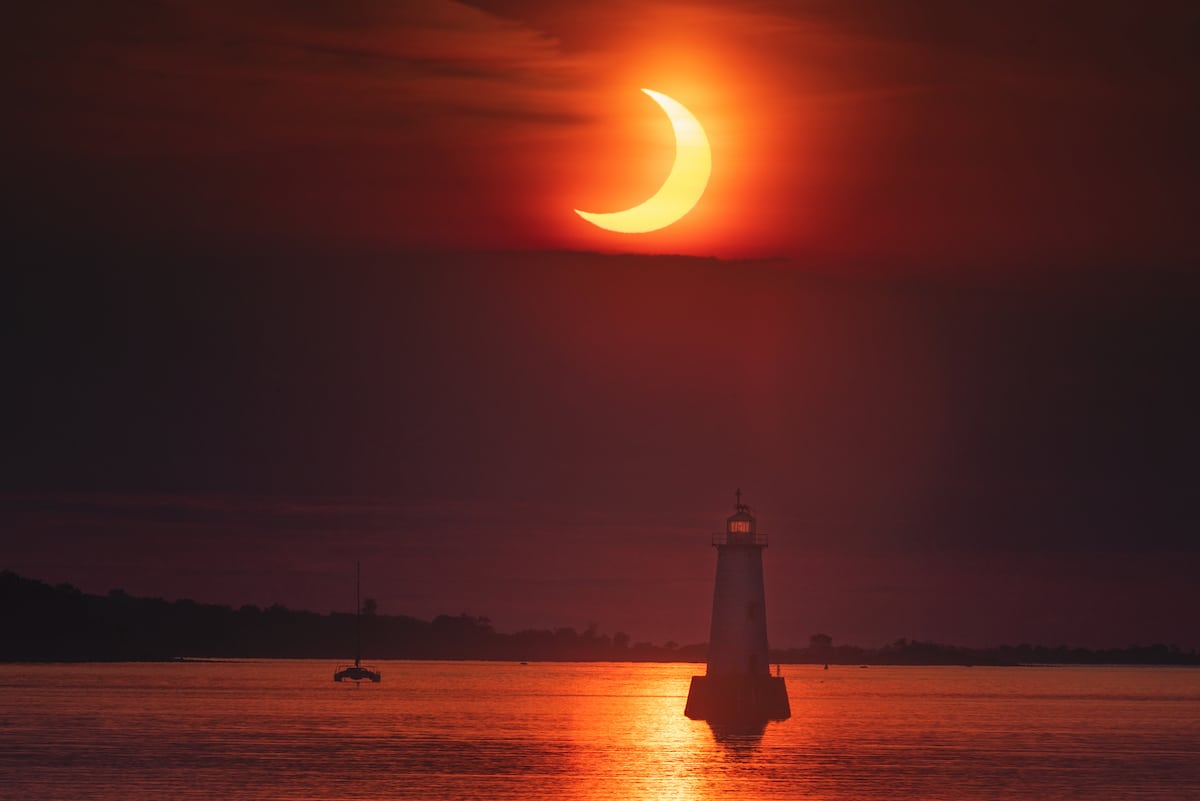
“Ring of Fire” by Sachin Jagtap (USA). Finalist.
“After much anticipation, Sachin captured this ‘ring of fire’ solar eclipse on 10 June 2021. Three days before it was due to happen, he had his camera ready, battery charged, and all the required filters. Unfortunately, the weather had other ideas – heavy rain and cloudy weather were predicted for the day, giving him less than a 10% chance of seeing it, but he decided to try anyway. The morning of the eclipse, Sachin woke at 3 am and drove for one hour to reach the New Jersey shoreline. The cloud was hanging low, but as his photo shows, the eclipse didn’t disappoint!
A solar eclipse occurs when the Moon passes between the Sun and Earth, casting a full or partial shadow. There are three types of solar eclipse: total, partial, and annular. It is the latter that Sachin has captured here, otherwise known as a ‘ring of fire’ eclipse. This occurs when the Moon is at its furthest point from Earth, on its elliptical orbit, and passes between the Sun and Earth. As a result of the distance from our planet, the Moon appears smaller than the Sun and so a bright ring of sunlight surrounds the Moon’s silhouette.”
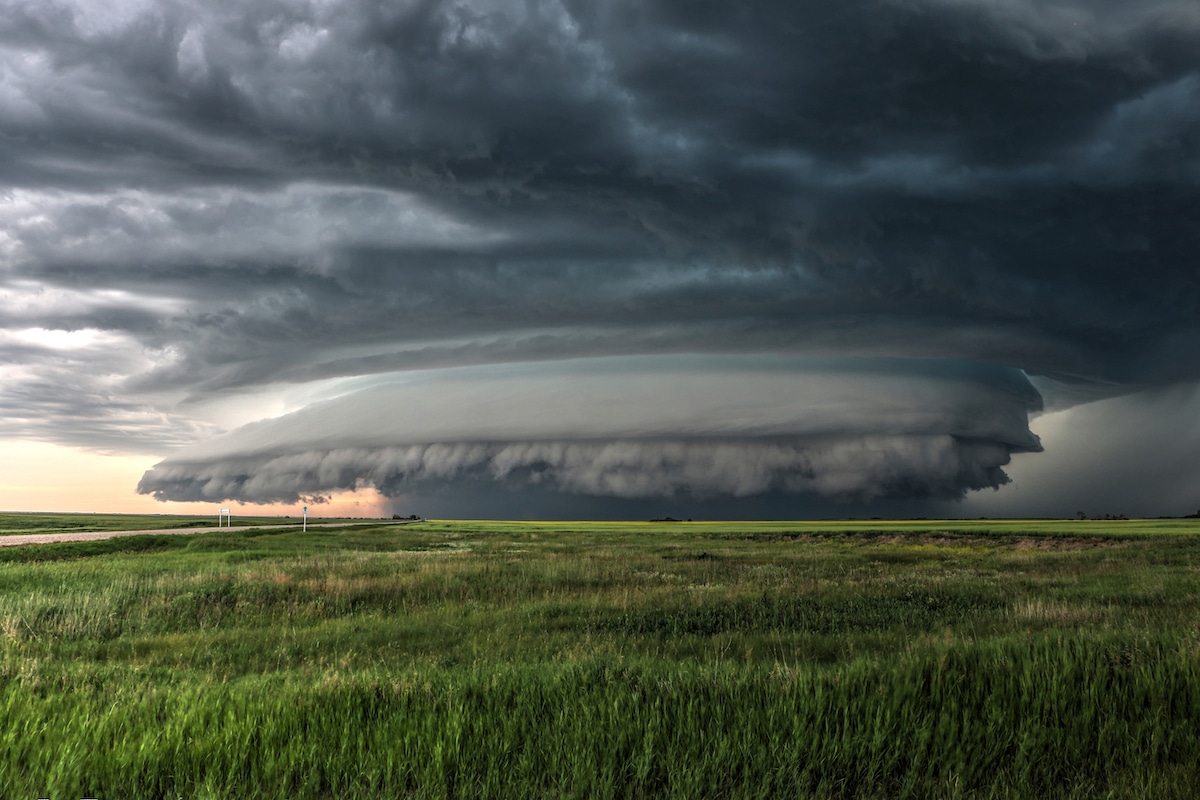
“Perfect Storm” by Craig Boehm (Canada). Finalist.
“Craig has been chasing and photographing storms for the last nine years. Out of all those years and images, this storm was the most photogenic of them all. It matched his mental image of a perfect prairie storm, hence the name of his photo.
The supercell captured here carried a tornado warning for some time, but it never produced one. However, it did drop baseball-sized hail to the north of Craig’s location, causing significant damage to areas in its path.
A supercell is a powerful thunderstorm with a deep rotating updraught (called a mesocyclone), capable of producing tornadoes, large hail, damaging wind gusts, and torrential rain. In addition to the usual ingredients required to develop a thunderstorm – instability, moisture and a lifting mechanism – supercells need strong vertical wind shear. This is a change in wind speed and direction with height, which allows the mesocyclone to form. As much power as these storms have, Craig finds it very calming to be sitting in front of one watching it approach.”
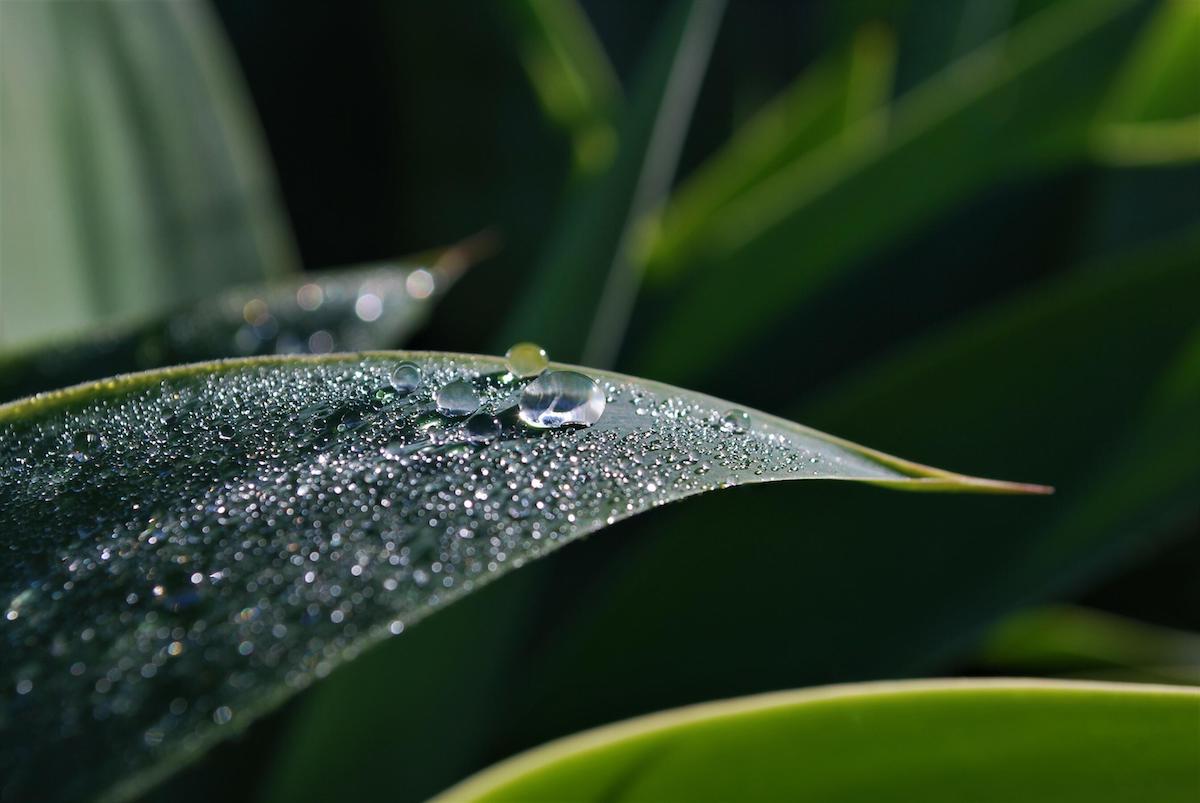
“Thunderstorm vs Beauty” by Fynn Gardner (14) (Australia). Runner-up, Young Weather Photographer of the Year.
“Fynn took this image in Frenchs Forest, New South Wales, Australia, just after a thunderstorm.
Severe thunderstorms are the most common and most damaging type of storm in New South Wales. Australia classifies a thunderstorm as ‘severe’ if it produces any of the following: hail measuring more than 2cm in diameter, wind gusts above 90 km/h, tornadoes, or heavy rain that leads to flash flooding.
Severe thunderstorms can happen all year round in New South Wales. However, they are most common from October to March, often referred to as the ‘severe thunderstorm season’.”
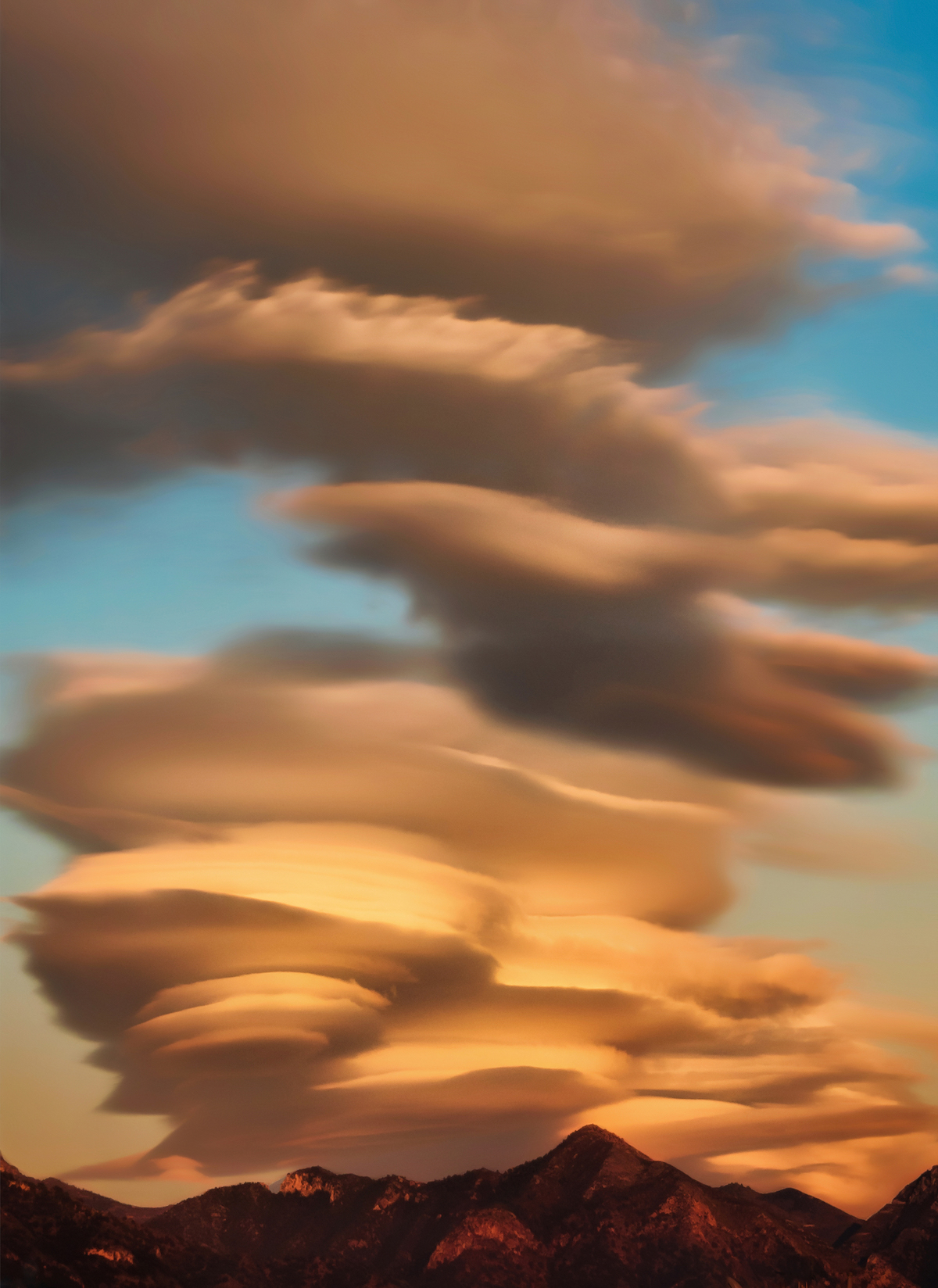
“Mountain Skyscape” by Angela Lambourn (UK). Finalist.
“During the late afternoon, following a midwinter’s day spent hiking in the mountains under a cloudless sky, Angela spotted these glorious lenticular clouds. They had developed above the mountains, behind the coastal town of Nerja on the Costa del Sol.
A lenticular cloud is a lens, or saucer-shaped cloud, which forms when stable air is forced to rise over a hill or mountain. This disturbance in the horizontal airflow can develop waves in the air downstream, similar to the ripples you see as water flows over a rock. These waves generally stay in the same place as the wind blows through them, hence their name ‘standing waves’. If the air is sufficiently moist, a lenticular cloud can form in the crest of a wave. Either directly over or just to the lee (sheltered side) of the mountain.
As Angela observed, close to sunrise or sunset, the display of these clouds often becomes more spectacular by the minute, with the golden light of the sun illuminating the clouds beneath.”
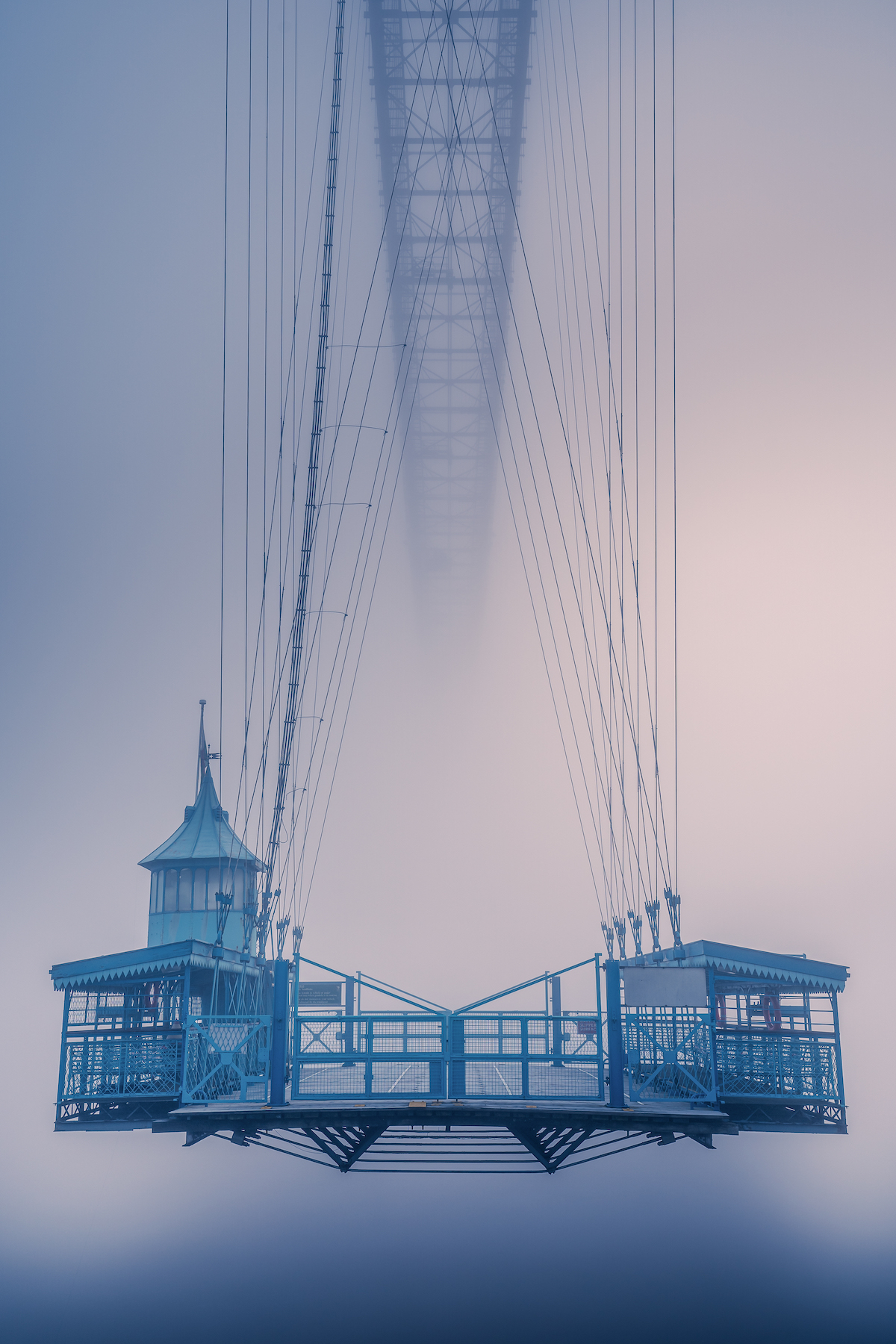
“Foggy Bridge” by Itay Kaplan (South Wales). Finalist.
“The Newport Transporter bridge crosses the River Usk in Newport, South East Wales and is essentially a suspended ferry. For a number of years, Itay waited for foggy conditions to surround the bridge, and in January 2021, that day finally came. Itay initially used his drone to track the movement of the fog before then setting up his camera to capture his image once the fog had thickened.
Put simply, fog is a cloud at ground level that is thick enough to reduce the surface visibility to less than 1km. A collection of tiny liquid water droplets, fog usually contains up to 0.5 ml of water within each cubic meter of air. This means that if you concentrated the water from an area of fog filling an entire Olympic swimming pool, you would only be left with around 1.25 liters of water. Different types of fog are classified according to their formation, with radiation fog, advection fog, upslope fog, and evaporation fog all common in the UK.”
